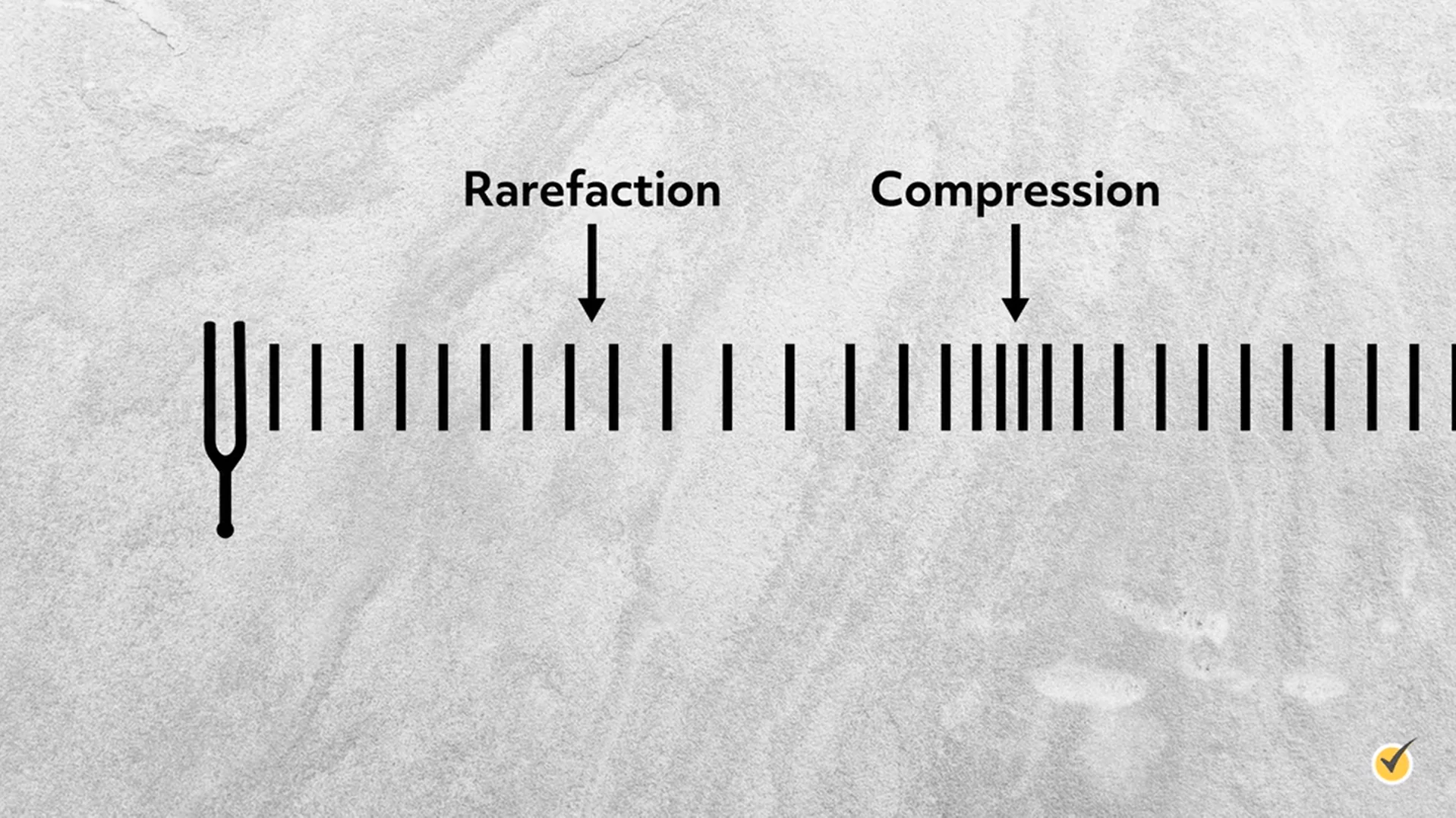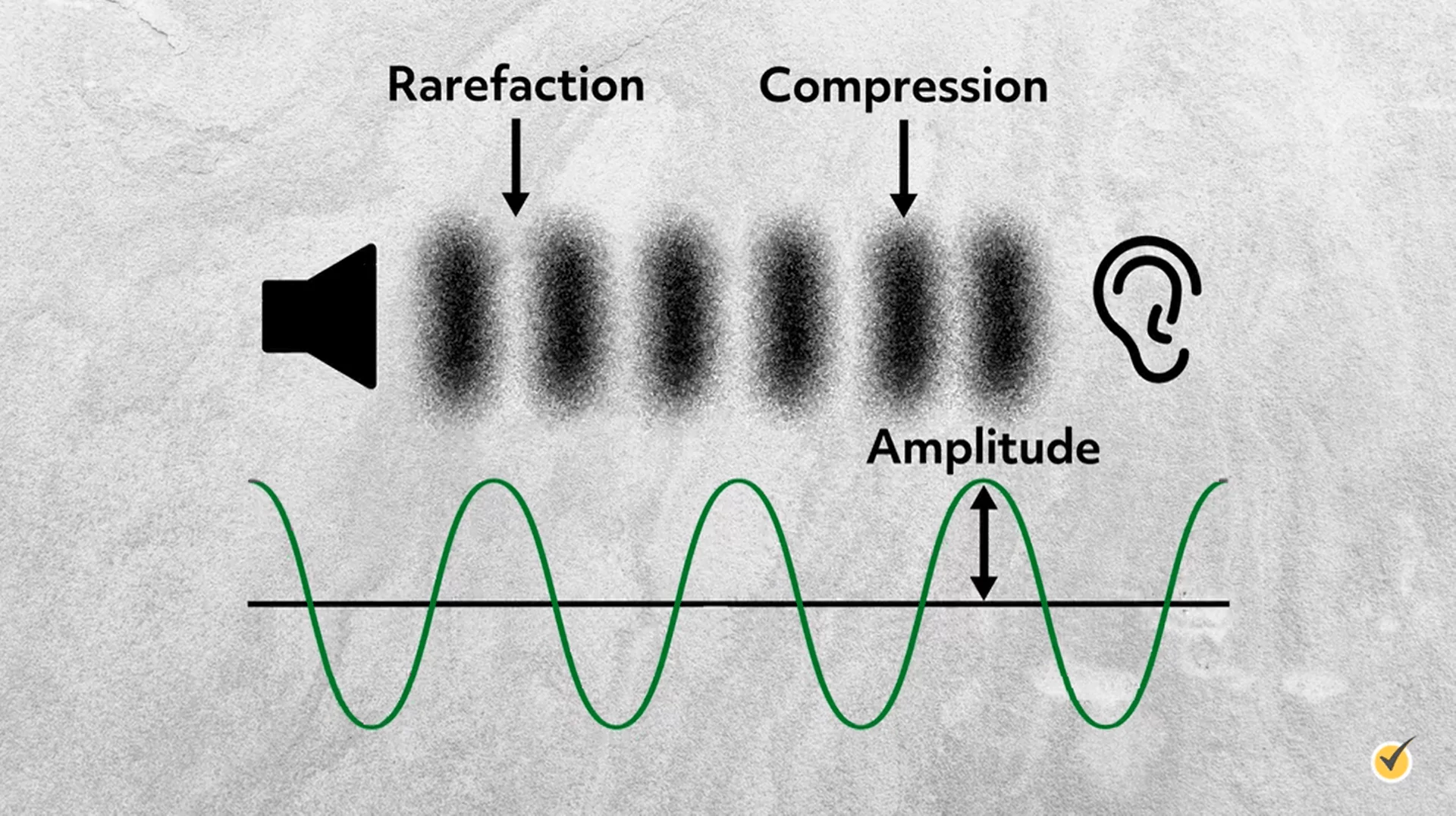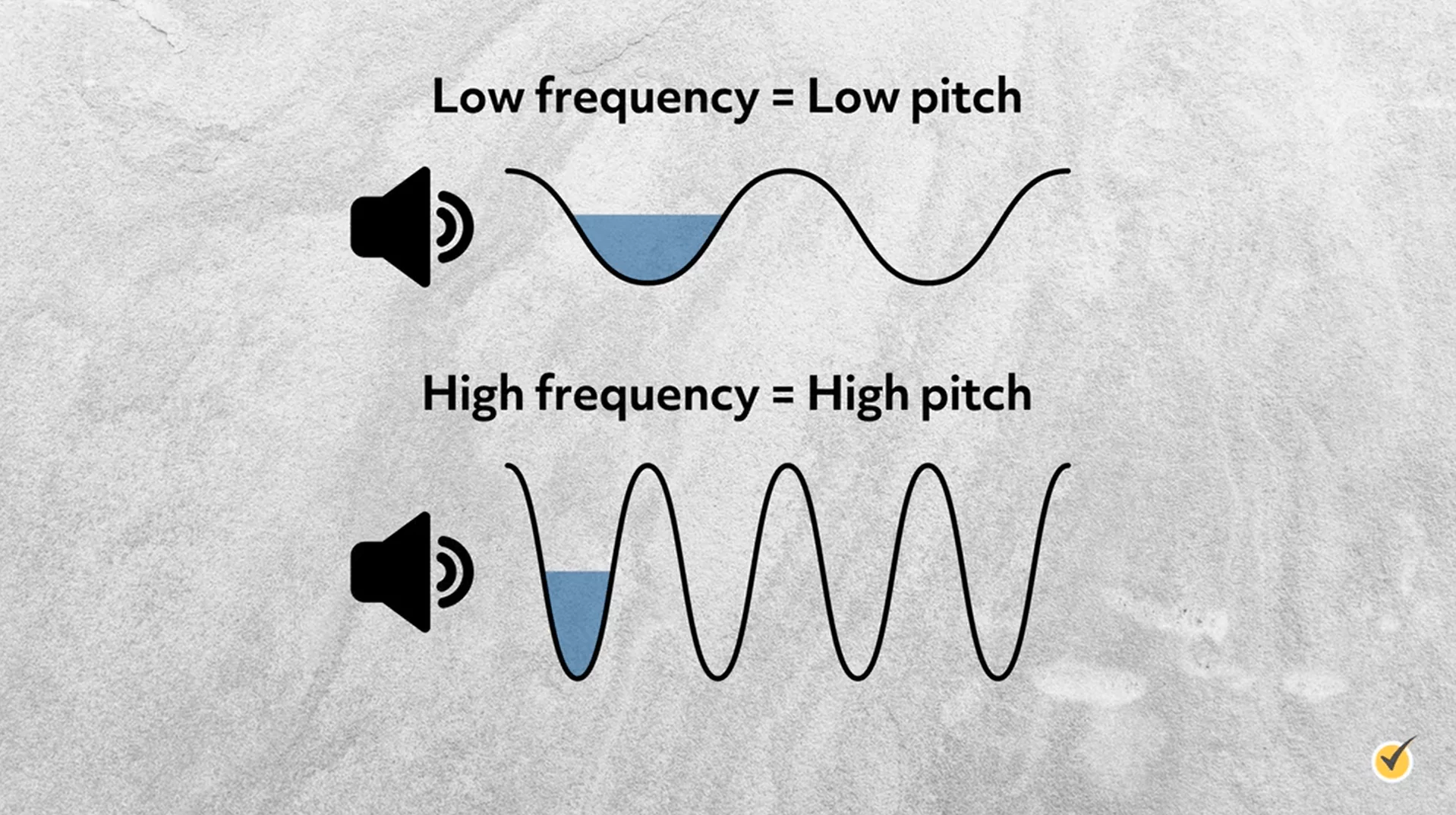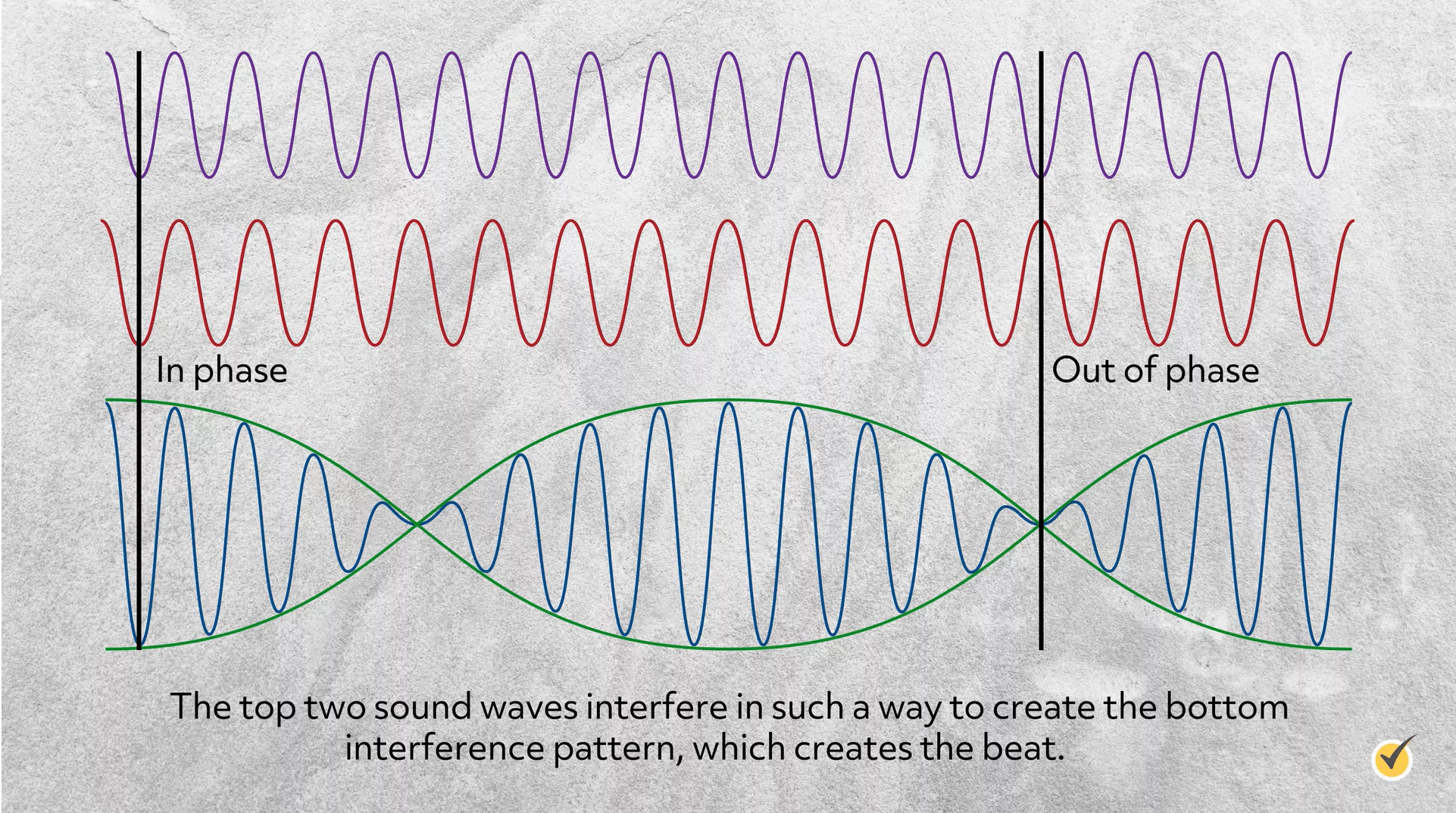Sound

Hi, and welcome to this video on the physics of sound! Today, we’ll discuss how sound waves work and how they relate to the pitch and intensity of sound.
So, how exactly do we hear sound? And what is sound, anyway?
Sound actually occurs as a result of vibrations in the air or in other materials. When something makes a sound, it vibrates and those vibrations are then transferred to the surrounding air (or other material) in a wave pattern. When that sound wave reaches our ears, it creates a vibration in our eardrums, which our brain interprets as a sound.
Wave Characteristics
Sound waves are a type of longitudinal wave, meaning that they vibrate in the same direction that they are traveling.
As the wave is travelling, there are variations in pressure occurring in the medium it’s travelling through. So, molecules in that medium are bunched up, or compressed, in the high pressure regions and spread apart in the low pressure regions, which is called rarefaction. We can see this at work in a tuning fork.
When the prong of a tuning fork vibrates in the air, the layer of air adjacent to the prong undergoes compression. When the prong moves back in the opposite direction, it leaves an area of reduced air pressure. It’s important to note that sound cannot occur in a vacuum, since there is no medium for it to travel through. This means that there is no sound in space, contrary to many movies or TV shows you may have seen!

The vibrations of the air or material that a sound is traveling through occur at a certain frequency. This frequency is measured in units of Hertz (Hz), or vibrations per second. A sound wave of 500 Hz, then, would have 500 vibrations per second, or 500 compressed areas traveling by a certain point per second. The speed that the wave travels depends on the medium that it is traveling through.

When the wave is vibrating at a high frequency, it emits a higher pitch, while lower frequencies result in a lower pitch.

Another defining characteristic of sound is its loudness. While loudness is not exactly a physical property itself, we can think about loudness in terms of power and intensity. Power is the rate at which energy is transferred through a sound wave, thus making it a measurement of how energetic the sound is. The intensity of the sound is the amount of power per area. In other words, intensity is:
where \(P\) is power and \(A\) is a certain area.
Sound intensity is also related to the change in the pressure from the wave (the amplitude), the density of the medium it is traveling through, and the speed at which the wave is travelling. We can see this using the following equation:
where \(∆p\) is the change in pressure, which is a representation of the amplitude of the wave; ρ is the density of the medium the wave is traveling though; and v is the speed of sound in a given medium. Both ρ and v vary somewhat with temperature. So, in problems dealing with sound, you may also be given a temperature in addition to the type of medium the sound is traveling through in order to look up the appropriate values for these variables.
Vibrations can occur at pretty much any frequency; however, human beings can only hear sounds in a certain frequency range, generally about 20 – 20,000 Hz. Of course, this varies a little from person to person and by age. As you get older, you can expect this range to get a little smaller.
The decibel scale is based on the lower limit of human hearing. On this scale, 0 dBis the lower limit of our hearing, meaning we hear complete silence. The sound intensity level, β, in decibels can be determined from the intensity by the equation:
where I is the intensity you are interested in and \(I_0\) is a reference intensity at the lowest range a person with average hearing can detect \(l_{0}=10^{-12}\text{} W/m^{2}\). When \(l=l_{0},B=0\), which is to be expected. Since the sound intensity level equation uses a log scale, every increase of 10 dB equals a tenfold volume increase!
Up until now, we’ve only discussed sounds that consist of a single sound wave and one frequency. Of course, in the real world, sounds change and some sound waves may interfere with others. One obvious example is music. No one wants to listen to a single monotonous tone. So how can we create some variation?
First, let’s talk about interference.
Interference
When two sound waves overlap, they can interfere with each other either destructively or constructively. If they interfere destructively, the high pressure areas meet up with the low pressure areas and they cancel each other out, which cancels out the sound. When they interfere constructively, the high pressure areas meet up and the low pressure areas meet up. This intensifies the sound, making the high pressure higher and the low pressure lower.

Most people are familiar with the sound of a beat in music. Beats occur when two sound waves that are slightly off in frequency interfere with each other. At some points, these waves will interfere constructively and at some points they will interfere destructively.

These occurrences will be periodic and have a frequency of their own, equal to the difference of the other two frequencies. For example, if our two frequencies are 225 Hz and 220 Hz, the beat frequency would be 225 Hz – 220 Hz = 5 Hz.
Review Questions
Okay, now that you know all about sound waves, let’s go over some review questions!
1. Most humans can hear sound in the frequency range of 20 – 20,000 Hz, and a dog whistle creates a sound wave with a frequency of about 23,000 Hz to 54,000 Hz. What does this tell you about a dog’s hearing abilities?
- Dogs only hear low pitched sounds.
- Dogs can hear much higher pitched sounds than humans.
- A dog can’t actually hear a dog whistle.
- Dogs can hear much louder sounds than humans.
The higher frequency of the dog whistle means it is higher pitched and dogs respond to this high pitched sound because they can hear it. The frequency range doesn’t necessarily relate to the “loudness” of the sound.
2. If two sound waves with frequencies of 354 Hz and 362 Hz interfere with each other, what will the beat frequency be?
- It will vary.
- 716 Hz
- 8 Hz
- 358 Hz
362 Hz – 354 Hz = 8 Hz.
That’s all for this review of sound waves! Thank you for watching, and happy studying!